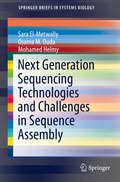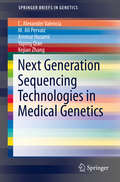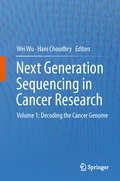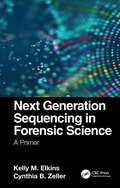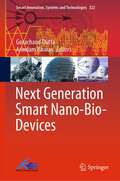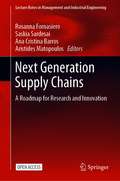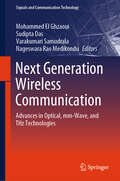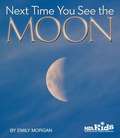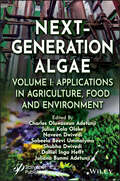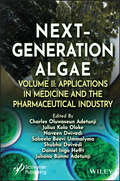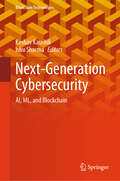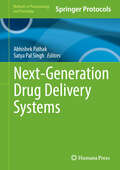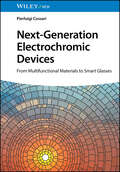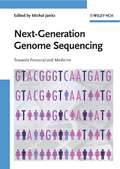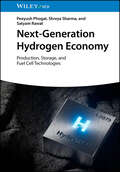- Table View
- List View
Next Generation Roadmapping: Establishing Technology and Innovation Pathways Towards Sustainable Value (Science, Technology and Innovation Studies)
by Dirk Meissner Tugrul U. Daim Robert Phaal Clive KerrRoadmapping is a structured visual approach for supporting strategic technology and innovation management, providing strategic navigational support (hence the “roadmap” metaphor) for technologists, designers, entrepreneurs, programme managers, executives, policy makers, other stakeholders involved in the formulation and implementation of strategy. This book brings together the latest developments in roadmapping, covering a range of practical issues and conceptual aspects. First, the book delves into the critical topic of strategic alignment within organizations, encompassing the interdependencies and synchronization of horizontal and vertical systems, connecting innovation priorities to strategic objectives, and the integration of key performance indicators. Then, the book concentrates on practical techniques and tools for roadmapping, including a template-based approach for technology venture funding. Social and digital aspects of roadmapping are explored, including workshop methods, considering how quantitative (analysis) and qualitative (expert) knowledge can be combined for improved strategic planning. Finally, a series of new case studies focusing on energy systems in Sub-Saharan Africa and Turkey illustrate the practical application of technology roadmapping and also provide useful insights. Roadmapping continues to evolve, as it is adapted to apply to new domains and strategic challenges, propagates to new sectors, and as new digital technologies such as AI emerge that radically affect strategy and innovation processes. The need for structured and engaging approaches such as roadmapping for navigating towards the future is essential.
Next Generation Science Standards: For States, By States
by Ngss Lead States“Next Generation Science Standards identifies the science all K-12 students should know. These new standards are based on the National Research Council’s A Framework for K-12 Science Education. The National Research Council, the National Science Teachers Association, the American Association for the Advancement of Science, and Achieve have partnered to create standards through a collaborative state-led process. The standards are rich in content and practice and arranged in a coherent manner across disciplines and grades to provide all students an internationally benchmarked science education. The print version of Next Generation Science Standards complements the nextgenscience.org website and: Provides an authoritative offline reference to the standards when creating lesson plans Arranged by grade level and by core discipline Printed in full color with a lay-flat spiral binding Allows for bookmarking”
Next Generation Sequencing
by Lee-Jun C. WongIn recent years, owing to the fast development of a variety of sequencing technologies in the post human genome project era, sequencing analysis of a group of target genes, entire protein coding regions of the human genome, and the whole human genome has become a reality. Next Generation Sequencing (NGS) or Massively Parallel Sequencing (MPS) technologies offers a way to screen for mutations in many different genes in a cost and time efficient manner by deep coverage of the target sequences. This novel technology has now been applied to clinical diagnosis of Mendelian disorders of well characterized or undefined diseases, discovery of new disease genes, noninvasive prenatal diagnosis using maternal blood, and population based carrier testing of severe autosomal recessive disorders. This book covers topics of these applications, including potential limitations and expanded application in the future.
Next Generation Sequencing Technologies and Challenges in Sequence Assembly
by Sara El-Metwally Osama M. Ouda Mohamed HelmyThe introduction of Next Generation Sequencing (NGS) technologies resulted in a major transformation in the way scientists extract genetic information from biological systems, revealing limitless insight about the genome, transcriptome and epigenome of any species. However, with NGS, came its own challenges that require continuous development in the sequencing technologies and bioinformatics analysis of the resultant raw data and assembly of the full length genome and transcriptome. Such developments lead to outstanding improvements of the performance and coverage of sequencing and improved quality for the assembled sequences, nevertheless, challenges such as sequencing errors, expensive processing and memory usage for assembly and sequencer specific errors remains major challenges in the field. This book aims to provide brief overviews the NGS field with special focus on the challenges facing the NGS field, including information on different experimental platforms, assembly algorithms and software tools, assembly error correction approaches and the correlated challenges.
Next Generation Sequencing Technologies in Medical Genetics
by C. Alexander Valencia M. Ali Pervaiz Ammar Husami Yaping Qian Kejian ZhangThis book introduces readers to Next Generation Sequencing applications in medical genetics. The authors discuss the direct application of next-generation sequencing to medicine, specifically, laboratory medicine or molecular diagnostics. The first part of the book contains chapters on sanger sequencing, NGS technologies, targeted-amplification and capture, and exome sequencing. The second part of the book focuses on genetic disorders diagnoses by NGS, prenatal diagnosis, muscular dystrophies, mitochondrial disorders diagnosis, and challenges in molecular diagnosis. Recent developments and potential future trends in NGS sequencing applications are highlighted, as well.
Next Generation Sequencing and Data Analysis (Learning Materials in Biosciences)
by Melanie Kappelmann-FenzlThis textbook provides step-by-step protocols and detailed explanations for RNA Sequencing, ChIP-Sequencing and Epigenetic Sequencing applications. The reader learns how to perform Next Generation Sequencing data analysis, how to interpret and visualize the data, and acquires knowledge on the statistical background of the used software tools. Written for biomedical scientists and medical students, this textbook enables the end user to perform and comprehend various Next Generation Sequencing applications and their analytics without prior understanding in bioinformatics or computer sciences.
Next Generation Sequencing and Sequence Assembly: Methodologies and Algorithms
by Ali Masoudi-Nejad Zahra Narimani Nazanin HosseinkhanThe goal of this book is to introduce the biological and technical aspects of next generation sequencing methods, as well as algorithms to assemble these sequences into whole genomes. The book is organized into two parts; part 1 introduces NGS methods and part 2 reviews assembly algorithms and gives a good insight to these methods for readers new to the field. Gathering information, about sequencing and assembly methods together, helps both biologists and computer scientists to get a clear idea about the field. Chapters will include information about new sequencing technologies such as ChIp-seq, ChIp-chip, and De Novo sequence assembly.
Next Generation Sequencing in Cancer Research, Volume 2
by Wei Wu Hani ChoudhryLatest generation sequencing revolutionizes the fields of cancer research and oncology. This follow-up volume focuses more extensively on single cell sequencing of cancer and trials in drug resistance. Another exciting feature is the bioinformatics tools given, that can be used on cancer genome studies. Scientists around the world are attempting to find the root cause of cancer. A reasonable cancer treatment plan and potential cure is more optimistic now with the unfolding of the cancer genome. The collective knowledge of how to leverage next generation sequencing in cancer research is paving the way. The important information provided in this volume will move the field forward in developing novel targeted cancer therapies.
Next Generation Sequencing in Cancer Research: Decoding the Cancer Genome
by Wei Wu Hani ChoudhryThis volume provides an interdisciplinary perspective of applying Next Generation Sequencing (NGS) technology to cancer research. It aims to systematically introduce the concept of NGS, a variety of NGS platforms and their practical implications in cancer biology.This unique and comprehensive text will integrate the unprecedented NGS technology into various cancer research projects as opposed to most books which offer a detailed description of the technology. This volume will present true experimental results with concrete data processing pipelines, discuss the bottleneck of each platform for real project in cancer research. In additional, single cancer cell sequencing as the proof of concept will be introduced in this book, along with cutting-edge information provided will help the intended audience to develop a comprehensive understanding of the NGS technology and practical whole genome sequencing data analysis and rapidly translate into their own research, specifically in the field of cancer biology.
Next Generation Sequencing in Forensic Science: A Primer
by Kelly M. Elkins Cynthia B. ZellerNext Generation Sequencing in Forensic Science: A Primer addresses next generation sequencing (NGS) specific to its application to forensic science. The first part of the book offers a history of human identity approaches, including VNTR, RFLP, STR, and SNP DNA typing. It discusses the history of sequencing for human DNA typing, including Sanger sequencing, SNaPshot, pyrosequencing, and principles of next generation sequencing. The chapters present an overview of the forensically focused AmpliSeq, ForenSeq, Precision ID, PowerSeq, and QIAseq panels for human DNA typing using autosomal, Y and X chromosome STRs and SNPs using the MiSeq FGx and Ion Torrent System. The authors outline the steps included in DNA extraction and DNA quantitation that are performed prior to preparing libraries with the NGS kits. The second half of the book details the implementation of ForenSeq and Precision ID to amplify and tag targets to create the library, enrich targets to attach indexes and adaptors, perform library purification and normalization, pool the libraries, and load samples to the cartridge to perform the sequencing on the instrument. Coverage addresses the operation of the MiSeq FGx and Ion Chef, including creating a sample list, executing wash steps, performing NGS, understanding the run feedback files from the instrument, and troubleshooting. ForenSeq and Precision ID panel data analysis are explained, including how to analyze and interpret NGS data and output graphs and charts. The book concludes with mitochondrial DNA (mtDNA) sequencing and SNPs analysis, including the issue of heteroplasmy. The final chapters review forensic applications of microbial DNA, NGS in body fluid analysis, and challenges and considerations for future applications. FEATURES Focuses on human identification using traditional and NGS DNA typing methods targeting short tandem repeats (STRs) Applies the technology and its application to law enforcement investigations and identity and ancestry single nucleotide polymorphisms (SNPs) for investigational leads, mass disaster, and ancestry cases Presents the underlying principles of NGS in a clear, easy-to-understand format for practitioners and students studying DNA in forensic programs This is the first book to prepare practitioners to utilize and implement this new technology in their lab for casework, highlighting early applications of how NGS results have been used in court. The book can be utilized for upper-level undergraduate and graduate students taking courses focused on NGS concepts. Readers are expected to have a basic understanding of molecular and cellular biology and DNA typing.
Next Generation Smart Nano-Bio-Devices (Smart Innovation, Systems and Technologies #322)
by Arindam Biswas Gorachand DuttaThis book addresses challenges for the development of a point-of-care-test platform. The book describes printed chip-based assay (Lab-on-a-Chip, Lab-on-a-PCB) for rapid, inexpensive biomarkers detection in real samples. The main challenges of point-of-care testing require implementing complex analytical methods into low-cost technologies. This is particularly true for countries with less developed healthcare infrastructure. Washing-free, Lab-on-Chip, and Lab-on-PCB techniques are very simple and innovative for point-of-care device development. The redox cycling technology detects several interesting targets at the same time on a printed chip. The proposed areas are inherently cross-disciplinary, combining expertise in biosensing, electrochemistry, electronics and electrical engineering, health care, and manufacturing. This book focuses on recent advances and different research issues in the nanobiotechnology-enabled biosensor technology and also seeks out theoretical, methodological, well-established, and validated empirical work dealing with these different topics.
Next Generation Supply Chains: A Roadmap for Research and Innovation (Lecture Notes in Management and Industrial Engineering)
by Rosanna Fornasiero Saskia Sardesai Ana Cristina Barros Aristides MatopoulosThis open access book explores supply chains strategies to help companies face challenges such as societal emergency, digitalization, climate changes and scarcity of resources. The book identifies industrial scenarios for the next decade based on the analysis of trends at social, economic, environmental technological and political level, and examines how they may impact on supply chain processes and how to design next generation supply chains to answer these challenges. By mapping enabling technologies for supply chain innovation, the book proposes a roadmap for the full implementation of the supply chain strategies based on the integration of production and logistics processes. Case studies from process industry, discrete manufacturing, distribution and logistics, as well as ICT providers are provided, and policy recommendations are put forward to support companies in this transformative process.
Next Generation Wireless Communication: Advances in Optical, mm-Wave, and THz Technologies (Signals and Communication Technology)
by Sudipta Das Mohammed El Ghzaoui Varakumari Samudrala Nageswara Rao MedikonduThis book provides an overview of the most common techniques and methods employed in wireless fields. Conversely, it delves into a detailed study of millimeter-wave (mm-wave) and terahertz (THz) systems, with a focus on various schemes for transmitting and receiving electromagnetic waves. The title comprehensively reviews key elements associated with wireless communications, emphasizing the generation and detection of mm and THz waves. It explores specifications, innovations in new materials for high-speed terahertz and millimeter-wave technology, and considerations related to components and system aspects. Additionally, the book explores the integration of machine learning (ML) and artificial intelligence (AI) in smart communication systems, along with potential applications for advanced wireless communications. Furthermore, it concentrates on recent advances and diverse research prospects in Next-Generation Wireless Communication Technologies. The book also seeks theoretical, methodological, well-established, and validated empirical work addressing these various topics.
Next Steps for TIMSS: Directions for Secondary Analysis
by Board on International Comparative Studies in EducationA report on Directions for Secondary Analysis
Next Stop Mars
by Giancarlo GentaThis book covers the possible manned mission to Mars first discussed in the 1950s and still a topic of much debate, addressing historic and future plans to visit the Red Planet. Considering the environmental dangers and the engineering and design needed for a successful trip, it covers every aspect of a possible mission and outpost. The chapters explain the motivations behind the plan to go to Mars, as well as the physical factors that astronauts on manned missions will face on Mars and in transit. The author provides a comprehensive exposure to the infrastructure needs on Mars itself, covering an array of facilities including power sources, as well as addressing earth-based communication networks that will be necessary. Mechanisms for return to Earth are also addressed. As the reality of a manned Mars voyage becomes more concrete, the details are still largely up in the air. This book presents an overview of proposed approaches past, present, and future, both from NASA and, increasingly, from other space agencies and private companies. It clearly displays the challenges and the ingenious solutions involved in reaching Mars with human explorers.
Next Time You See the Moon
by Emily MorganThis book inspires children to observe the Moon. Readers will learn how the Moon's changing shape is caused by its orbit around the Earth.
Next War: Reimagining How We Fight
by John F. Antal"...a useful addition to the literature of the changing character of war. Its scoping and focus, and its application of the identified disruptors to current challenges offer immediate insights for today’s commanders and defence policymakers." — The Wavell Room The nature of war is constant change. We live in an era of exponential technological acceleration which is transforming how wars are waged. Today, the battlespace is transparent; multi-domain sensors can see anything, and long-range precision fire can target everything that is observed. Autonomous weapons can be unleashed into the battlespace and attack any target from above, hitting the weakest point of tanks and armored vehicles. The velocity of war is hyper-fast. Battle shock is the operational, informational, and organizational paralysis induced by the rapid convergence of key disrupters in the battlespace. It occurs when the tempo of operations is so fast, and the means so overwhelming, that the enemy cannot think, decide, or act in time. Hit with too many attacks in multiple domains, all occurring simultaneously, the enemy is paralyzed. In short, the keys to decisive victory in war is to generate battle shock. Imagine a peer fight against Communist China, a new war in Europe against a resurgent Russia, or a conflict against Iran in the Middle East. How can our forces survive an enemy-first strike in these circumstances? Can we adapt to the ever-accelerating tempo of war? Will our forces be able to mask from enemy sensors? How will leaders execute command and control in a degraded communications environment? Will our command posts survive? Will our commanders see and understand what is happening in order to plan, decide, and act in real time? This book addresses these tough questions and more.
Next-Generation Algae, Volume 1: Applications in Agriculture, Food and Environment
by Charles Oluwaseun Adetunji Juliana Bunmi Adetunji Naveen Dwivedi Shubha Dwivedi Julius Kola Oloke Sabeela Beevi Ummalyma Daniel Ingo HefftNEXT-GENERATION ALGAE This book brings together experts in relevant fields to describe the successful application of algae and their derivatives in agriculture, improving agricultural sustainability, harvesting and processing, food security, fishery, aquafarming, agriculture pollution, and state-of-the-art developments of algae in commercial and agriculture utilization. This book provides up-to-date and cutting-edge information on the application of algae in producing sustainable solutions to various challenges that arise from an increase in agricultural production, as well as its utilization in the bioremediation of industrial wastewater. Moreover, the book provides detailed information about the recent advancements in smart microalgae wastewater treatment using Internet of Things (IoT) and edge computing applications. Other topics covered include the use of microalgae in various applications; the use of algae to remove arsenic; algae’s role in plastic biodegradation, heavy metal bioremediation, and toxicity removal from industrial wastewater; the application of DNA transfer techniques in algae; the use of algae as food and in the production of food, ascorbic acid, health food, supplements, and food surrogates; relevant biostimulants and biofertilizers that could be derived from cyanobacterials and their role in sustainable agriculture; and algae’s application in the effective production of biofuels and bioenergy. Audience This book is aimed at a diverse audience including professionals, scientists, environmentalists, industrialists, researchers, innovators, and policymakers who have an interest in bioremediation technologies for extremely polluted environments, especially in water, air, and soil.
Next-Generation Algae, Volume 2: Applications in Medicine and the Pharmaceutical Industry
by Charles Oluwaseun Adetunji Juliana Bunmi Adetunji Naveen Dwivedi Shubha Dwivedi Julius Kola Oloke Sabeela Beevi Ummalyma Daniel Ingo HefftNEXT-GENERATION ALGAE The book comprehensively details the novel and biologically active compounds derived from algae for sustainable healthcare delivery that could be used for the treatment of an ever-increasing population, prevention of high rate of morbidity rates, as well as in the treatment of numerous diseases, and serve as an alternative drug for the prevention of high level of resistance to synthetic drugs. This second volume places a special emphasis on the discovery of novel and biologically active compounds from algae. It covers a wide range of applications, including the use of astaxanthin and carotenoids derived from algae for the production of nutraceuticals, pharmaceuticals, additives, food supplements, and feed. The book also discusses the production of polyunsaturated fatty acids (PUFAs) and their biomedical applications, recent advancements in the research of sulfated polysaccharides from algal origin, and their antiulcer bioactivities. Other topics include the application of algae in wound healing, the use of nanotechnology for the bioengineering of useful metabolites derived from algae and their multifaceted applications, and the production of single-cell proteins and pigments with high relevance in the industry. Audience Researchers in industry and academia as well as clinicians in the fields of microbiology, biotechnology, and food science will find this book very pertinent.
Next-Generation Cybersecurity: AI, ML, and Blockchain (Blockchain Technologies)
by Keshav Kaushik Ishu SharmaThis book highlights a comprehensive overview of the recent advancements and challenges in the field of cybersecurity with a focus on the integration of artificial intelligence (AI), machine learning (ML), and blockchain technologies. The book targets both researchers and practitioners working in the field of cybersecurity and aims to fill the gap in the current literature by providing a comprehensive and up-to-date examination of the integration of AI, ML, and blockchain in cybersecurity systems. The book has a technical focus and provides an in-depthexamination of the latest developments in the field. It covers a range of topics including the basics of AI, ML, and blockchain, the application of AI and ML in cybersecurity, the use of blockchain in cybersecurity, and the integrationof AI, ML, and blockchain in cybersecurity systems. Each chapter is written by leading experts in the field and provides a thorough and technical overview of the topic, including case studies, examples, and practical applications.
Next-Generation Drug Delivery Systems (Methods in Pharmacology and Toxicology)
by Abhishek Pathak Satya Pal SinghThis book provides a detailed yet accessible guide to emerging trends in drug delivery systems. Topics encompass a wide range of delivery mechanisms, including nanotechnology-based carriers, controlled-release formulations, targeted delivery systems, and biologics, with a focus on their role in improving therapeutic outcomes. Emphasis has also been placed on regulatory challenges, translational research, and the integration of artificial intelligence in designing advanced drug delivery systems. Written for the Methods in Pharmacology and Toxicology series, chapters include the kind of specificity and expert implementation advice to ensure success in the lab. Comprehensive and practical, Next-Generation Drug Delivery Systems serves as an ideal guide to how innovative drug delivery approaches can address critical challenges, such as enhancing bioavailability, reducing side effects, and achieving precise drug targeting.
Next-Generation Electrochromic Devices: From Multifunctional Materials to Smart Glasses
by Pierluigi CossariComprehensive reference focusing on features of promising new materials and devices for electrochromic and integrated multifunctional systems Next-Generation Electrochromic Devices: From Multifunctional Materials to Smart Glasses covers the basic concepts and the potential use of electrolytes, conducting polymers and multifunctional materials for the development of electrochromic (EC) and integrated systems, focusing on the influence of solid-state electrolytes and interface features on the design of new device structures and simplified manufacturing. The book is divided into three parts. Part I explores the chemistry of the main components of devices with a special focus on the main critical material issues, covering mixed-ion and electron conductors, electrodes, and more. Part II describes EC and multifunctional devices, such as photoelectrochromic smart windows and see-through ECOLED displays, and the main characterization techniques for the study of material properties, interfaces and device performance. Part III comprehends device manufacturing, scale-up procedures, and discusses the main benefits of smart windows in terms of energy savings, visual comfort, and environmental impact, proposing contextually a multitude of pioneering ideas and concepts with a specific insight into emerging devices in the era of Artificial Intelligence (AI), immersive reality and invisible technologies. Next-Generation Electrochromic Devices includes information on: Inorganic and organic electrochromic materials, including graphene, 3D transitional metal oxides, Prussian blue, viologens, conducting polymers, organic mixed ionic and electronic materials, and highly transparent electrodes Electrolytes including inorganic, liquid, gel, and solid-state polymers, their ionic conductivity and transport properties Thin film deposition methods: chemical deposition through solution processing techniques, sol-gel, Langmuir-Blodgett, electrochemical and physical deposition by means thermal and electron-beam evaporation, sputtering, pulsed laser, and molecular beam epitaxy deposition Electrochemical analysis of materials, interface, and device durability Organic mixed ionic and electronic conductor materials for innovative and multifunctional optoelectronic systems Optical, structural, chemical, and physical methods for the study of electrochromism and material properties including NMR, X-Ray diffraction analysis, XPS, UV-Vis, FTIR, and Raman spectroscopy Energy efficiency of EC glazings and their impact on thermal and visual comfort Emerging materials for chromogenic systems, smart windows, and new energy devices Fully integrated ECOLED see-through displays and multifunctional smart devices for immersive reality and invisible technologies Impact of AI and next-generation technologies on social, human, and environmental changes Next-Generation Electrochromic Devices is an essential reference on the subject for materials scientists, chemists, physicists, as well as architects, electrical and civil engineers. It can be also a source of inspiration for artists, graphic designers, and art workers.
Next-Generation Genome Sequencing: Towards Personalized Medicine
by Michal JanitzWritten by leading experts from industry and academia, this first single comprehensive resource addresses recent developments in next generation DNA sequencing technology and their impact on genome research, drug discovery and health care. As such, it presents a detailed comparative analysis of commercially available platforms as well as insights into alternative, emerging sequencing techniques. In addition, the book not only covers the principles of DNA sequencing techniques but also social, ethical and commercial aspects, the concept of personalized medicine and a five-year perspective of DNA sequencing.
Next-Generation Hydrogen Economy: Production, Storage, and Fuel Cell Technologies
by Peeyush Phogat Shreya Sharma Satyam RawatProvides a comprehensive guide to hydrogen technologies for sustainable energy production and practical deployment With the growing urgency to reduce greenhouse gas emissions, decarbonize heavy industries, and diversify energy sources, hydrogen stands out as a versatile, clean energy carrier. Next-Generation Hydrogen Economy: Production, Storage, and Fuel Cell Technologies serves as an interdisciplinary roadmap for understanding and leveraging hydrogen’s vast potential. This timely volume meets the pressing need for a unified, research-informed resource that integrates hydrogen science, engineering, and policy—addressing both theoretical foundations and real-world implementation. Written by experts in material science and energy research, Next-Generation Hydrogen Economy thoroughly examines hydrogen’s role in modern and future energy systems. The authors explore advanced production methods such as electrolysis, photocatalysis, and biological synthesis, while also detailing innovative storage technologies including metal hydrides, metal-organic frameworks (MOFs), and liquid organic hydrogen carriers (LOHCs). Practical chapters on hydrogen fuel cells highlight applications in transportation, grid storage, and heavy industry, with in-depth discussions on commercialization, economic feasibility, infrastructure challenges, and safety standards. Bridging research and practice, the book also delves into AI-driven catalyst development, smart hydrogen cities, and other emerging areas in the fields. Equipping readers with the knowledge to drive innovation and make informed decisions in the rapidly evolving hydrogen economy, Next-Generation Hydrogen Economy: Integrates multidisciplinary insights from material science, electrochemistry, energy systems, and public policyHighlights novel hydrogen production techniques including photocatalysis and biological routesAnalyzes the techno-economic challenges and opportunities of industrial-scale hydrogen deploymentFeatures clear diagrams and process flowcharts to illustrate complex technical concepts and up-to-date case studies and global policy frameworks to contextualize hydrogen adoptionDiscusses safety standards, regulatory compliance, and risk mitigation strategies for hydrogen technologies Emphasizing cross-sectoral integration of hydrogen, Next-Generation Hydrogen Economy: Production, Storage, and Fuel Cell Technologies is ideal for graduate and postgraduate students in courses such as Renewable Energy Systems, Energy Materials, and Sustainable Engineering within physics, chemistry, and energy engineering programs. It also serves as a valuable reference for professionals in electrochemistry, clean energy R&D, and energy policy analysis.
Next-Generation Nanobiosensor Devices for Point-Of-Care Diagnostics
by Gorachand DuttaThis book reviews the potential of next-generation point-of-care diagnosis in healthcare. It also discusses the printed chip-based assay (Lab-on-a-Chip, Lab-on-a-PCB) for rapid, inexpensive biomarkers detection. The book presents the development of sensory systems based on the use of nanomaterials. It examines different biosensors for medical diagnosis using surface modification strategies of transducers. It presents electrochemical concepts based on different nanobiomaterials and nanocomposites for cancer theranostics. Notably, the book examines the recent advances in wearable, cost-effective hemodynamic sensors to detect diseases at an early stage. It further explores the combination of redox cycling and electrochemical detection to develop ultrasensitive and reproducible biosensors for point-of-care testing. Finally, the book summarizes the significant challenges in the point of care diagnostics and its future opportunities in healthcare.



